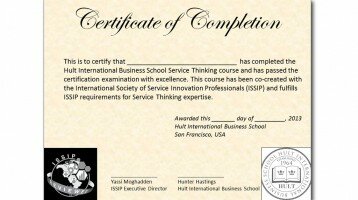Service Thinking in Action
On this page, we’ll be collecting links to real-world use-cases of Service Thinking. We’ve divided the case studies into broad categories.
Service Thinking Case Studies: Cognitive Computing
OrCam is a smart camera mounted on the frames of your eyeglasses, which “sees” text, recognizes objects and “whispers” in your ear. (Camera as a service.)
- OrCam-
OrCam harnesses the power of Artificial Vision to compensate for lost visual abilities. OrCam is a sensor that sees what is in front of you, understands what information you seek and provides it to you through a bone-conduction earpiece.
OrCam is a smart camera mounted on the frames of your eyeglasses, which “sees” text, recognizes objects and “whispers” in your ear.
The OrCam device enables you to read books or newspapers, verify money note denominations, and even identify which product or item you are pointing at.
- Most careers in the era of cognitive systems have not been invented yet-
Jean Paul Jacob (IBM Research Emeritus) alerted me to this NYT article “Automation Alone Isn’t Killing Jobs” …
If the transition to the industrial age is any guide, most of the jobs and types of careers in the age of smart machines do not exist yet. The era of cognitive systems is just beginning to dawn.
Service Thinking Case Studies: T-Shaped Organizations and Professionals
The boundary-crossing competencies of the “T” Source: T-Summit 2014
- T-Summit 2014-
Cultivating Tomorrow's Talent Today
Join us for a gathering of industry, higher education, professional associations, and government leaders to explore how we can collectively innovate undergraduate learning in order to cultivate tomorrow's talent. A service-based economy increasingly demands individuals with deep disciplinary knowledge, the ability to understand and work within complex systems, and the ability to collaborate across disciplinary boundaries (T-Shaped). T-Summit 2014 will explore what we can only do in partnership and what each partner uniquely brings as we focus on preparing future talent.
- IDEO CEO Tim Brown: T-Shaped Stars: The Backbone of IDEO’s Collaborative Culture -
An Interview with IDEO CEO Tim Brown by Morten T. Hansen
IDEO is a world-leading design firm, with offices in Palo Alto, San Francisco, London, Boston and Shanghai, among other places. Consistently ranked as one of the most innovative companies in the world, IDEO is famous for its method of innovation based on intense cross-disciplinary project work. To pull this off, the company has long practiced the art of collaboration and the development of a certain kind of talent: T-shaped people.
- Introducing T-Shaped Managers: Knowledge Management’s Next Generation-
by Morten T. Hansen and Bolko von Oetinger
T-shaped management relies on a new kind of executive, one who breaks out of the traditional corporate hierarchy to share knowledge freely across the organization (the horizontal part of the “T”) while remaining fiercely committed to individual business unit performance (the vertical part). The successful T-shaped manager must learn to live with, and ultimately thrive within, the tension created by this dual responsibility. Although this tension is most acute for heads of business units, any T-shaped manager with operating unit obligations must wrestle with it.
- T-shaped Professionals, T-shaped skills, Hybrid managers-
By David Ing
The science, management and engineering of service systems is associated with a call for T-shaped people. The most recent emphasis is on T-shaped professionals, which was preceded by T-shaped skills, with linkages back to a 1990 study on hybrid managers. Some insight can be gained by working backwards through the nuanced terms.
- The War for Talent and Open Innovation-
by Henry Chesbrough
In a world of open innovation, the really scarce and valuable resource is what my Berkeley colleague Morten Hansen refers to as “the T-shaped manager”. Companies who compete to hire these specialists will need to invest in substantial training to cultivate and nurture T-shaped managers. Yet it will be these folks who are the real prize to be won in the war for talent.
- Beyond IT Report: IBM's Role in Creating the Workforce of the Future-
IBM’s goal is to help promote the creation of T-shaped people.
These graduates have deep skills in their chosen discipline, broad understanding of a number of complementary fields and complete familiarity and comfort in using IT to address their needs.
